By Benjamin Nobel, December 5, 2019

As seen on slab labels for multi-pack variants for Wonder Woman v2 #1 (1st Modern app. of Themyscira, Gaea’s, Girdle, Hippolyte, Ares & The Olympian, Gods. New origin; recent CGC label shown), Batman #357 (1st appearances of Killer Croc, (Waylon Jones) & Jason Todd; recent CGC label shown), and Spectacular Spider-Man #27 (1st Frank Miller Daredevil art; recent CBCS label shown).
The Wonder Woman v2 #1 “No Month Variant,” the Batman #357 “Pre-Pack Edition,” and the Spectacular Spider-Man #27 “3-Pack Variant” presently have three different variant names on slabs as per the grading company labels shown at right; but these three comics all share several common attributes including: (a) they were distributed in multi-packs, and (b) there is no cover month on them.
This “aka No Month” comic book category seems like it is a great fit for the Two Ways to Win collecting strategy, but, there are also some challenges; today I explore these three interesting multi-pack-distributed example comics. I will make observations about: their relative rarity versus the corresponding “regular” copies, the current marketplace availability of listings where sellers are not clued in to what they own being different, the “stigma” problem/challenge with these books as I see it, and the “what to call them” question/debate.
![]()
The Ole “What To Call Them” Question
In our hobby, there is no one standard-setting “independent board” or “consortium” or “panel” to set standards that the various authorities in the hobby must then all follow… instead, every individual company sets its own standards. In this way, our hobby is less organized than phone emojis. There’s an independent non-profit consortium that sets the standards by committee used by all the world’s cell phones so that everyone agrees that “🙂” is a smiling face (can you imagine hearing someone vehemently argue that it should actually be called a frowning face?).
But meanwhile in our comic book hobby, there is often major disagreement about what to call different comic book situations. And multi-pack comics of the 1970’s and 1980’s appear to be another one of these situations where a great many different naming conventions are applied, depending on who you ask and which specific comic you ask about. To explore the situation, I’m going to start with Wonder Woman v2 #1 (DC Comics, 2/1987). For this particular issue, there was both newsstand distribution (including a $1.00 price variant) and direct sales to comic shops. And then there were also these (left: front of pack; right: back of pack):


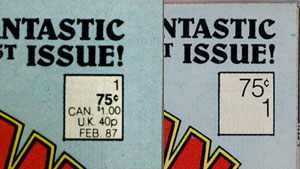
Left: regular direct edition; Right: “No Month” variant (at the bottom of the box, “Feb 87” is absent).
As it turns out, the “logo box” itself also differs for this issue (more on this later):

Left: regular direct edition; Right: “No Month” variant.
CGC denotes such copies of Wonder Woman v2 #1 on census as “No Month” Variant, and with this naming choice appears to be zeroing in on the missing cover month as the important/defining physical feature that the variant-name-wording then draws upon:

And this naming choice is understandable and makes logical sense; I can picture a conversation like this: “What should we call these? Well, they have no cover month; that looks like the most major physical feature that differs from the regular ones… so let’s call them “No Month” Variants.” Makes sense and sounds reasonable, right?
As to why the month was omitted from such books in the first place, it would certainly make business sense in the context of these multi-packs to omit the month, so that they would remain appealing to potential buyers for a longer time (having no month on them means there was nothing to immediately give the packs away as being old / out of date).
Moving back in time by four years, Batman #357 (DC Comics, 3/1983) is similar to the Wonder Woman example: there was both newsstand distribution (including a 75¢ price variant) and direct sales to comic shops. And then there were multi-pack distributed copies which have no month shown on the cover (and here, the “logo box” looks the same as the type direct-sold to comic shops).

Left: regular direct edition; Right: “No Month” Variant aka “Pre-Pack Edition” (“Mar.” is absent under “No. 357”)
Inside this particular pack, the other two comics were World’s Finest #289 (3/1983) and DC Comics Presents #55 (3/1983). With these Batman #357 multi-pack copies, CGC has chosen the name “Pre-Pack Edition” when breaking them out on census:

This naming choice has logic behind it too, because after all, they were only sold pre-packaged together with two other comics from the same publication month. So why not call them a “Pre-Pack Edition” by that logic? Makes sense and sounds reasonable, right?
And moving back in time by another four years, a final example I’d like to present today is from over at Marvel: Peter Parker, the Spectacular Spider-Man #27 (2/1979). Notice on the bag below that we see the “Whitman” logo and “Distributed by Western Publishing” (which are both on the plastic bag, not the printed comic itself).

Here once again we have a comic book that was distributed in multi-packs — the other two in the above pack were Tarzan #21 (2/1979) and Iron Man #119 (2/1979) — but unlike the DC examples before, which were both published in the 1980’s when there was already a corresponding comic-shop direct edition that the no-month copies could be compared to (and confused with), here with this Marvel example we don’t have a separate corresponding comic-shop direct edition, because we’re in February of 1979 when this comic was published.
To provide some context for the publication date of February 1979, it was around this time early in 1979 that Chuck Rozanski of Mile High Comics was about to prompt a major change in comic book distribution, via a letter-writing campaign seeking change at Marvel — this would ultimately land him in New York in May of 1979 to meet with Marvel executives, as he describes in his multi-part article series entitled “Evolution of the Direct Market” which begins here at Part I (and is something I’d highly recommend reading, as it is absolutely fascinating).
“What had started out as simply a long-shot letter writing campaign designed to encourage Marvel to pressure Phil Seuling’s Seagate Distributing company to start offering comics retailers 30-day credit terms, miraculously became the turning point in the entire history of direct distribution of comics.”
— Chuck Rozanski, Becoming a Marvel Distributor
Rozanski refers to Seagate in the quote above. Seagate, founded in 1972 by Seuling, pioneered the idea of ordering comics from publishers on a non-returnable basis (and because of this commitment, securing a large discount), and distributing them directly to specialty comic shops. As Rozanski describes it, for most comics retailers of the time there was essentially no option but to purchase from Seagate, both because of the discount and also because of a sweetheart shipping logistics arrangement that Seagate had secured — the end result of which was that comic shops could get their books a full week earlier than via their local independent distributor wholesaler.
This last point appears to be critical to the story of the evolution of the direct market. Rozanski cites a statistic of the time, that over on newsstands, 70% of the sales for a given comic book issue were made within the first 10 days of the comic book being placed on the newsstand. And by ordering their books from Seagate, comic shops could get their books into the hands of fans a full week before they hit the (competing) newsstands in town… In this way, comic shops were able to capture a huge share of comic sales within their local markets, by beating the newsstands to the sale.
“Based on conversations I’ve had with other comics retailers from those early days, this huge timing advantage was the primary catalyst for the explosive growth in comics shops throughout the country during the 1972-1977 period.”
— Chuck Rozanski, Evolution of the Direct Market (Part II)
But a disadvantage of ordering from Seagate was that they demanded payment up front, at the time orders for comics were submitted, which could be months before they actually shipped. This tied up precious business capital for long periods and was effectively a lack of extension of credit, which is ultimately what Rozanski was fighting for, and what landed him at Marvel.
Rozanski describes his meeting with Marvel executives as happening in May of 1979, with the key players including Ed Shukin, Marvel’s Vice President of Marketing. Rozanski describes how this all ultimately led to Mile High Comics becoming the first new Marvel distributor under the new trade terms offered in June of 1979.
Rozanski describes how this development placed Ed Shukin in the position of having to explain to the many local magazine distributors around the country, why Marvel selling directly to comics shops (like Mile High) was not going to hurt them. And one of the complaints Ed needed to quell, was about how some comics shop owners were buying comics from Seagate at a large discount — comics that should have been non-returnable, but then secretly returning those books through their local distributor (as if they were newsstand returns) and pocketing the spread. The solution?
“To quell these complaints, Ed agreed to remove the bar code from all comics being sold to comics distributors, replacing them with logos, or small ads. Thus the concept of “Direct Market” editions was born.”
— Chuck Rozanski, Newsstand Editions History
When did comic shops begin receiving these specially-marked versions as the new standard? According to Rozanski, this happened in June of 1979:
“For those of you who go back and look at the earliest Direct Market editions, they have only a simple slash through the bar code. This began in June of 1979.”
— Chuck Rozanski, Newsstand Editions History
Nick Pope confirms this date for the “new standard”:
“Starting with comics cover dated June 1979, Marvel began sending diamond cover issues to subscribers and comic shops. At this point diamond cover issues became the de facto standard for Direct Sale destinations.”
— Nick Pope, BIP Comics: Marvel Diamond Issues, 1977-1979
But what about the Spectacular Spider-Man #27 copy we saw before, published February of 1979? Is it a “Direct Edition”? Well, it certainly is “non-newsstand” (marked differently when it was printed so that such copies could not be returned for refund). Instead of a bar code (or a slashed-through bar code), such copies simply have a blank box:

So such copies were distinguishable from the returnable newsstand copies, and, they were direct-sold to Western for their Whitman multi-pack program on a non-returnable basis… Some would therefore argue that these attributes, by definition, makes them bona fide Direct Edition copies and that is what we should be calling them: Direct Editions. I do see the strength to this logic, even if these copies did not end up being sold by a comic shop.
And, there are even mentions out there of anecdotal reports from some comic shop owners, that they recall receiving the Whitman multi-pack type of copy in their stores at different points in time (perhaps not Spectacular Spider-Man #27 specifically with its lack of cover month but there are also other styles/designs at different points in time — more on this later). If comic shops got them too from time to time, wouldn’t that definitively make them “Direct Editions?” Case closed on what to call them? Actually, there is more to the history…
“While it is true Western Publishing was the largest distributor of these early diamond issues between 1977-1979 there is anecdotal evidence that indicates they were not the only distributor. Recollections of several dealers have indicated that they had received diamond issues at varying points in time prior to 1980. Regardless of these recollections, it is clear that Western Publishing was the driving force behind these early diamond cover print runs.”
— Nick Pope, BIP Comics: Marvel Diamond Issues, 1977-1979
And John Jackson Miller of Comichron confirms that Whitman multi-pack copies like our Spectacular Spider-Man #27 example were created specifically for Western Publishing’s Whitman three-pack program, as opposed to being created to also be distributed to comic shops via Seagate, something he confirmed with Jim Shooter:
“When I asked [Shooter] about reports of direct market retailers having bought copies from the Whitman run, Shooter said he did not believe that any dealers received any copies from it. Phil Seuling’s direct-market pioneering Seagate was getting Curtis newsstand copies, he said, which was why the move to a special non-newsstand trade dress was eventually made in 1979. I’m not sure how to reconcile that with the anecdotal reports: since the logo for that was a squashed diamond shape (and, reportedly, inspiration for the name Diamond Comic Distributors), it’s possible some retailers were remembering receiving later issues not from the 1977 to early 1979 Whitman run.”
— John Jackson Miller, Jim Shooter on Marvel Whitmans
Miller also explains how the ordering of Star Wars books reveals that Western Publishing was truly in the driver’s seat when it came to the production of multi-pack-type copies of the time:
“Once the [Star Wars] movie was released and retailers knew they had a blockbuster on their hands, multiple printings of the early issues were ordered, both by Curtis Circulation — and, most consequentially, by Whitman for use in special Star Wars three-packs. The result was that the early issues of the title were the first comics to exceed 1 million copies per issue in sales since Uncle Scrooge and Walt Disney’s Comics & Stories in 1960. According to Jim Shooter, later Marvel’s Editor-in-Chief, “Star Wars saved Marvel” in the late 1970s. Demand was so high for the reprints of the adaptation that Whitman only ordered Star Wars three-packs from Marvel for several months, perhaps explaining why there are no Whitman variants of other Marvel titles for a period in late 1977, corresponding to early 1978 cover dates. That fact also helps explain why the “fat-diamond” versions of Marvel’s comics in 1977-78 are better referred to as Whitman or special-market editions rather than Direct Market editions.”
— John Jackson Miller, Star Wars Comics Sales History
So what Miller is teaching us here, is that the variant printings that we see in multi-packs of this time period only existed because of the arrangement with Whitman; he’s pointing out that when Whitman was fully focused on ordering just Star Wars books, printings like this for other Marvel issues took a pause… In other words, what Miller is pointing out here, is that Marvel didn’t bother creating copies like this for a given book when Whitman didn’t place an order for that book, thus illustrating that their purpose truly was for Whitman multi-packs. Had their purpose for creation been also to be sent to comic shops too, wouldn’t Marvel have continued to print them even when Whitman didn’t want any? Yet they did not.
This is a compelling point, especially in connection with what Rozanski taught us about the reason behind the advent of the “bar-code-strikethrough” in June 1979 in connection with the new trade terms: that this was done to quell complaints that some comic shops were ordering from Seagate on what was supposed to be a non-returnable basis, but then returning those books sneakily, through the newsstand channel. Shops couldn’t have returned copies of Spectacular #27 from the Whitman multi-pack run through the newsstand channel, because they were already marked differently to be distinguished as non-returnable… So, the sneakily-returned books they got from Seagate must therefore have been from the same run as the newsstand copies, right? Otherwise there wouldn’t have been a reason for the complaint in the first place. And Jim Shooter’s confirmation that Seagate was getting the same copies as Curtis got for newsstands, corroborates this notion.
I respect the arguments on both sides of the what-to-call-these question; and I love it when there is respectful debate in our hobby. I can definitely see the logic behind calling such copies Direct Editions but I can also definitely see the logic behind the advice of John Jackson Miller, that Whitman multi-pack comics like this “are better referred to as Whitman or special-market editions rather than Direct Market editions.”
And by the variant names we see chosen by other big players in the hobby, there appears to be support for the notion that the name we use to refer to them should perhaps have more to do with the fact that the books exist courtesy of Whitman 3-packs. MyComicShop for example, uses the name “Whitman Variant” for them:

MyComicShop refers to this type of variant as “Whitman Variant” in their online catalog.
Mile High Comics also uses the variant name “WHITMAN”:
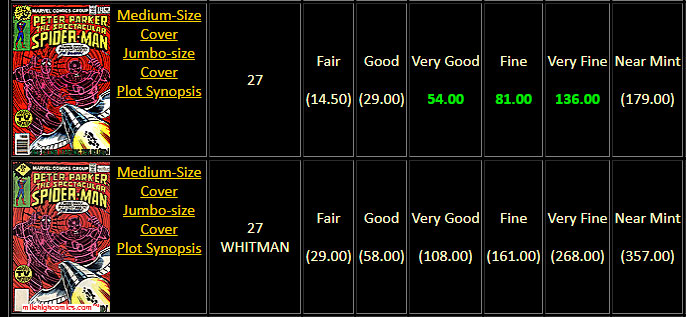
Top: Mile High Comics online catalog listing for “regular” copies; Bottom: Mile High Comics online Catalog listing for “Whitman” copies.
On the other hand, using “Whitman” in the name we call such comics might confuse/conflate these with the variants that have the Whitman logo as part of the comic itself; in the case of the Whitman packs containing Marvel comics, there’s no actual printed component on the books that refers to Whitman in any way. Whitman is all over the plastic bag but not anywhere as part of the printed comic. For contrast, here below is Action Comics #481, regular (left) and Whitman variant (right):
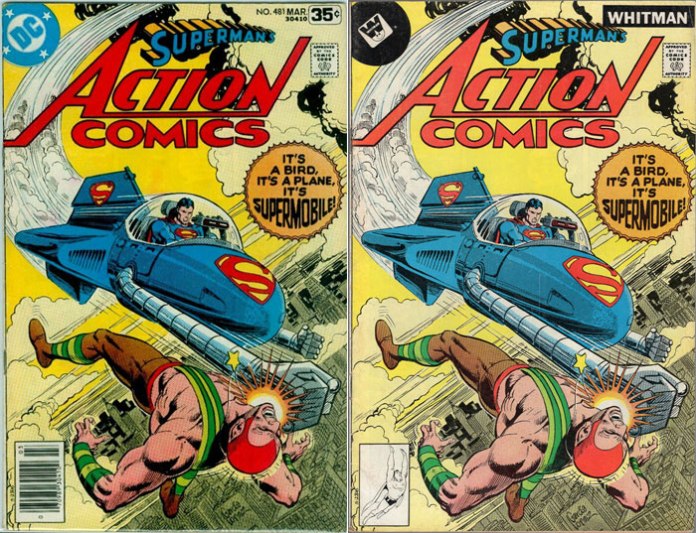
These actually have the Whitman markings on the printed comic, which is meanwhile not the case for our Spectacular Spider-Man #27 multi-pack example (only the plastic bag was marked). So arguably including “Whitman Variant” in what we call our Marvel examples could confuse/conflate them with books that actually have Whitman markings on the printed comic.
And perhaps in consideration of this, CBCS denotes the Spectacular #27 variants simply as “3-Pack Variant” (no “Whitman” in that variant name):

I respect the naming choices of each of these participants in the hobby (the variety of opinions truly shows that this is no phone emoji [no agreed-upon standard everyone then follows]).
But I’d now like to “raise my hand” here and point out as part of the “what to call them” debate, that there’s an important “physical feature” of the Spectacular Spider-Man #27 multi-pack variant version, that it shares in common with both the Batman #357 example and the Wonder Woman v2 #1 example from earlier: the Whitman 3-pack copies of this particular issue also have no cover month, whereas the “regular” copies do:
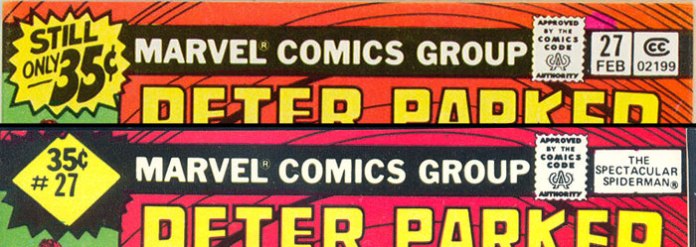
Top: regular copies have the issue number at the top right and “Feb” underneath; Bottom: the multi-pack copies have the issue number under the price at the top left, and No Month listed (instead “The Spectacular Spiderman” takes up the box along the top right).
Setting aside any debate/question over who may have gotten these variant copies (and would comic shops really have gotten copies with no cover month on them?) — all that aside, I’d like to argue as follows: If we’re going to pick an important physical feature of these variants to point out how they differ from their “regular” counter-parts, the absence of a cover month seems like a pretty darn important physical difference to highlight, does it not? (Sure, there are several other differences, but if we were to rank each difference by order of criticality, isn’t the lack of a month a pretty big deal? Wouldn’t that at least “tie” with having no bar code?)
I personally really kind of like the “ring” to CGC’s “No Month” Variant name that they already have in place for the Wonder Woman example. So I’d like to suggest that the idea be explored for application of this same treatment for those instances among Whitman multi-pack Marvel comics where there is no cover month, like in the case of Spectacular Spider-Man #27. Which brings me to the concept of “variant-worthy” attributes, and whether lack of a cover month is/should-be such an attribute in the eyes of the grading companies like CGC, in the context of their stance on treatment of newsstand versus direct-sold comics.
![]()
CGC “Variant-Worthy” Attributes
In the world of CGC, as their current policy stands today, there is no difference (to them) between Newsstand and Direct Edition comics when it comes to cataloging comic books onto their census: instead of differentiating them as distinct versions worthy of being labeled and counted separately, instead, CGC’s current “default” is to pretend they are identical and lump them together on census. I hate this policy and I wish CGC would follow in the footsteps of CBCS and start breaking out newsstand from direct editions broadly. The two versions are not the same; pretending they are identical is absurd.
But, fortunately, there are a number of “special situations” that cause CGC to break from their default stance and differentiate newsstand comics as distinct census variants. I’ve written about these special situations extensively on this blog; a couple of the major “variant-worthy attributes” are (1) a difference in cover price between the types and (2) when the newsstand version is “mis-identified” by its UPC code as a different title than it actually is. [“Variant-worthy attribute” in this context means something about the comic that “elevates” it (in CGC’s eyes) to census-variant-status as opposed to falling under their default stance of pretending the newsstand and direct edition versions are the same and lumping them together.]
What About the “No Month” Attribute? Is It Variant-Worthy? Should It Be?
When there is a “regular” version and a “no month” version, does that difference rise to the level of a “variant-worthy” attribute? As precedent, we saw earlier that CGC already “breaks out” the multi-pack copies of Wonder Woman v2 #1 as well as Batman #357 in order to differentiate them from their “regular” counterparts.
While both of those DC cases have a “regular” direct edition type that the no-month-variants could otherwise be confused with, and the Spectacular Spider-Man #27 does not — so there is certainly that difference in play — it is also the case that CGC’s default is to pretend that the newsstand and direct edition types are equivalent and to “lump them together”… And so, if they are lumped together into one “regular” entry, then isn’t the No Month Variant by extension effectively being differentiated not from the direct edition type (which after all isn’t separated), but from the “regular census entry” as a whole?
And if a No Month Variant should be differentiated from a “regular” census copy as reflected in their treatment of Wonder Woman v2 #1, then isn’t it a valid argument that CGC should also consider “breaking out” Whitman 3-pack copies of Spectacular Spider-Man #27 for this same reason/attribute, given that it too has no cover month?? I think this situation is ripe for brand-new census entries to be created — a new CGC-recognized “class” of variants is warranted — and I suspect that if the right person presented CGC with the request in person at a show (with example books in hand to illustrate the point), they might grant the request and elevate the “no month attribute” up to variant-worthy-attribute-status.
I already tried to ask CGC about this myself… I approached their Customer Service team with the question by email, presenting to them how the Wonder Woman books are already being “broken out” on census as “No Month” Variants as a precedent, and then I showed them how the very same attributes of (a) having been distributed in multi-packs and (b) having no cover month, were also exhibited by the Spectacular Spider-Man #27 variants. I fear I may have used too many words and pictures to explain what I was pointing out (you know me, dear reader, I can be verbose!), and they may have merely glanced through what I sent them and thought I was trying to once again encourage them to break out newsstand versus direct edition broadly (a case I’ve made to them in the past without success). Because after weeks of follow-ups without a response, I finally received a very generic short boilerplate reply indicating that their policy is not to differentiate between newsstand and direct edition comics. At that point I gave up. But I think if someone else were to try making the case too, there is a good chance CGC could eventually be swayed.
On a related note, have you recently looked up CGC’s census entries for some of the “big event” late modern issues with lots of different cover variations? I happened to look up Amazing Spider-Man #800 the other day… Do you know how many variant census entries CGC has entered into their system for just this one issue? There are so many I lost count as I was scrolling down, so instead I did a “find-in-page” for the phrase “country/variant” and the browser tells me there are fifty nine instances of that phrase in the page (here is a link to a census lookup for ASM #800):
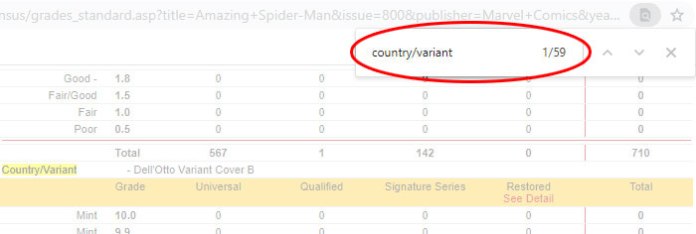
There are 59 “Country/Variant” instances for just this one individual issue, including A through F variations for just Dell’Otto variant covers alone.
If CGC is happy to input over fifty census variants for different covers of this one modern issue number in respect of the commercial benefits of doing so, I’d think they could spare a small number of entries for some 1970’s “No Month” variants, in respect of the interesting history behind these books and the fact that they are unmistakably physically different and discernable, and one of the two types has no cover month.
Plus, their main competition, CBCS, breaks them out as variants. On this point, something I find amazing is that CGC is willing to invest sums of money into their “crossover” grading service (giving up a portion of their regular fee in order to lure customers into submitting books to CGC that are already graded by competitors), and yet, they won’t invest into labeling all newsstand and direct-sold comics distinctly, because of the cost to make that happen!? During this year and last, I’ve submitted a great many books to CBCS over CGC purely because CBCS dignified those certain books with a variant label while CGC would not have.
I hope someone reading this will be inspired to try requesting of CGC yourself that they “break out” the “No Month” copies of Spectacular Spider-Man #27 and others like it (more in a bit on where to find others like it); I think that whenever there is a distinct census variant on record, it really helps people to realize they have a choice among different types they can collect for a given issue, when they might not have realized before that there was more than one type out there. More information is good for collectors and on account of their dominant status at present as the biggest grading company, CGC is looked to as a key authority for such information.
Anyone looking up a census entry to find out, for example, how many CGC 9.8’s there are on record for Spectacular Spider-Man #27, would, with a new census entry for the variant, then be able to see that there is another variant type out there which they can look for (something they may not have realized prior to doing the census lookup). And having a distinct census entry also draws attention to (and allows us to study) the relative rarity data between types. People would be able to see the number of variants submitted over time versus regular copies — which is important data that helps collectors make decisions. In fact, I’m about to refer to the census in exactly this way, in the next section.
![]()
Relative Rarity of “No Month” / Pre-Pack / 3-Pack Variants
As a group, there are lots of these multi-pack-type comics out there. Coming across a multi-pack-type comic is not difficult in and of itself (we could say the same for other “categories” of comics that we love and collect, that coming across a member of that category is not difficult). But a more relevant question to our collecting decision-making when hunting for a particular issue that has multiple types we can choose to collect, is whether the multi-pack type is more rare than the regular copies (and by how much?). To study this question, let’s start with the Spectacular #27 example.
CBCS does “break them out” as variants but has not yet released their census at the time I am writing this, and absent a CGC census entry for the multi-pack version of Spectacular Spider-Man #27, how might we study their relative rarity compared to regular copies? Arguably the next best method of study is to take a look at the marketplace availability between the types. For example, as of this particular moment in time, when I do an eBay search on “Spectacular Spider-Man #27” and review all the listings that come up, I count 5 multi-pack-type copies, versus 129 regular copies. That’s roughly 1:25 or in percentage terms a smidge under 4% of marketplace copies.
With Wonder Woman v2 #1 and Batman #357, we fortunately do have CGC census data available for the multi-pack copies. There, for Wonder Woman there are 1,583 “regular” copies on record as of today, 15 CPVs, and 28 “No Month” Variant copies. That’s about 1:58 of the total CGC-graded copies on record for the issue number being the No-Month type or in percentage terms a smidge under 2% of census copies. And then over at Batman #357, the census records show 1,329 “regular” copies on record as of today, 19 CPVs, and 37 “Pre-Pack Edition” copies (the “No Month” ones). That’s about 1:37 of the CGC-graded copies on record being the No-Month type or in percentage terms a smidge under 3% of census copies.
So we appear to be looking at low-single-digit percentages here across the board of the three issues, for the percentage rarity of “aka No Month variants” versus total copies of the issue number out there. That’s a rarity level worth paying attention to, especially if it is the case that such copies are readily available on the marketplace unidentified as variants — i.e. where their owner is not clued in to there being anything different or special about their copy versus the rest. Is that the case?
![]()
“Mis-Listed” Collecting Opportunity
I looked on eBay just now for each of the three books I’ve mentioned in this post, to see if I could find listings where the variant is pictured but meanwhile not identified in any way in the title or description, as being a variant. Sure enough, I quickly found examples for each one.
Here’s an active Wonder Woman v2 #1 listing showing a variant in the picture but not mentioning it as a variant in the listing title nor description:

A quick visual give-away is the logo box with its diagonal text; the variant is clearly pictured, but not mentioned in the listing title, nor in the description.
Here’s an active Batman #357 listing showing a variant, but not mentioning it in the title nor description:

The Batman variants are harder to spot because the logo box is a match to regular direct editions; here is one, but not mentioned in the listing title, nor the description, as being a variant.
The Batman variants are harder to spot among other listings, because the logo box is a match to regular direct editions; you may need to zoom in on listing pictures to enlarge the price box to reveal if the month is missing under the “No. 357”:

And here’s an active Spectacular Spider-Man #27 listing, picturing the variant but not mentioning it in the title nor description:

With the diamond price box and the blank logo box, these are easy to spot.
So indeed, we have a marketplace situation where there are sellers out there who are not listing these more-rare copies as variants. This could make them great candidates for collecting the variants at “regular price” from sellers who are unaware of the difference, but, there are also challenges … One which I already touched upon is that only two out of the three comics I’ve highlighted today have variant CGC census entries… But there is also another challenge: I perceive there to be a “stigma” problem, which I’ll cover next, posing a challenge to this “class” of comics.
![]()
Reprint Stigma
With each of the three example comics that I’ve presented here, I’ve found that there is a stigma problem ranging from minor to severe. I’ve personally only collected two of these three thus far to personally examine them with my own hands (the Batman #357 first and then the Spectacular Spider-Man #27); and when I acquired my Batman #357 I was 50/50 expecting to find a Second Printing indication in the indicia. Because here’s the thing: while Mile High Comics lists it as a “NO MONTH” variant (not as a second printing)…
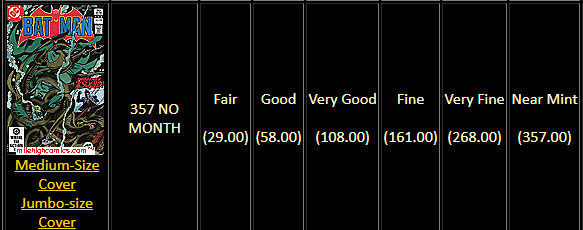
… and while CGC catalogs the book together with the other 3/1983 copies without referring to it as a second printing, other sources I found out there have suggested it is actually a second printing. For example, here’s MyComicShop’s listing which says “2nd printing – No month printed on cover”:

MyComicShop’s listing says “2nd printing – No month printed on cover (sold in 3-pack with World’s Finest #289 and DC Comics Presents #55).
Something else suspicious is that there is no Atari insert, whereas all the other types have it. And an early marketplace copy I came across when I was first discussing these (in the blog’s comments forum) also held it out to be a second printing, in the listing title (“Batman #357 1983 DC Comic Book. First Appearance of Killer Croc Scarce 2nd Print”).
So when I collected my own “No Month” copy of Batman #357, I wasn’t fully sure what I was going to see when I turned to the indicia page. Would there be a second printing indication that CGC had somehow missed but MyComicShop caught? I was pleased to find that indeed the book was published in March of 1983 with no indication in the indicia or elsewhere on the book that I could find that it was a second printing. Here’s an indicia photo of my copy:

I presume that the Wonder Woman v2 #1 variant must have a 1st print indicia as well (I haven’t held that one in my hands yet to personally verify it), but, it too has a stigma problem, as I see it. Remember earlier I pictured the front and back of a multi-pack, with issues #1-3 all included? Issue #3 wasn’t published until April. And remember earlier I pointed out that the “logo box” on the No Month Variant copies is not a match to the regular direct edition copies of issue #1?

Left: regular direct edition; Right: “No Month” variant.
As it turns out, examining issues #1-7 of the title (regular direct edition copies), we find that the logo box style/contents that we see on the No Month Variant (“Who watches the Watchmen” in diagonal font) was not introduced onto regular direct edition copies until issue #7 in August; and for other titles too, like Batman, it was only introduced in August as well:

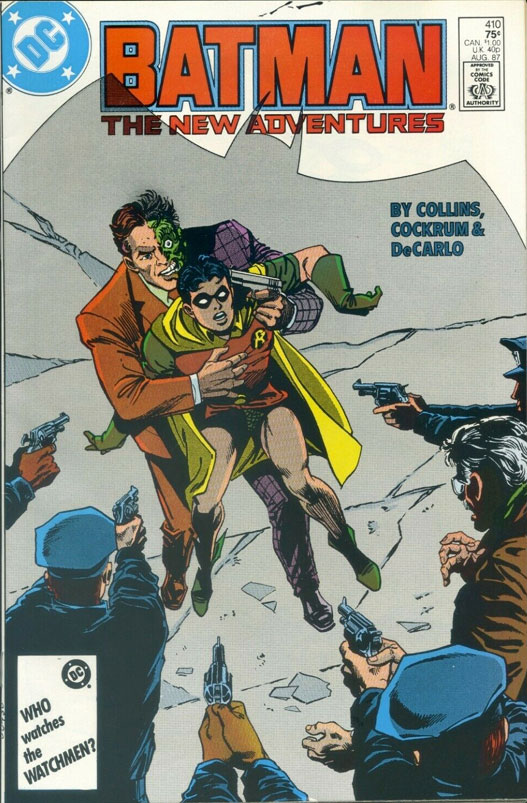
For a 2/87 first print copy to have an attribute on it that we don’t see on other issues until 8/87, raises eyebrows and is reminiscent of the ThunderCats #1 Situation of what looks to have been an unremarked second printing (a situation which also involved multi-packs).
But this is not to say that later printings cannot be highly collectable (and sometimes more highly valued than 1st printings); in fact there are many such instances of later printings being much more sought after (and more highly valued) than the first printing. One example is Spider-Man #1 (1990) — of all the various versions that Overstreet lists in their guide, the one ascribed the highest value of all is “Gold 2nd printing w/UPC code”:

Another example is Incredible Hulk #377:

What these instances (and others like it) have in common, is that the later printing with the huge ascribed value number is more rare than the first print copies by some large degree (and then widespread awareness of that rarity difference is achieved throughout the hobby).
The Biggest Stigma of All
For the Whitman multi-pack Spectacular Spider-Man #27 we have a reprint stigma that is very strong, and seems to all trace back to Star Wars #1 — speaking for myself I can definitely say this is the case for me (i.e. the source of the stigma in my own collecting experience), and it appears I am not alone. For me, it was the “warnings” when hunting for 35¢ variant copies of Star Wars #1 that laid the groundwork for general distrust of the Whitman multi-pack version… because that version was to be avoided, as a “trick”.
No collector wants to inadvertently be swindled into buying a low-value reprint thinking it is really a 1st print Type 1 cover price variant! And the Whitman packs for Star Wars #1 were just that — a cautionary tale of something to know about in order to avoid it. Because such copies carry that magic 35 cent price tag… and yet they are reprints.
Making matters even worse in the trickiness department, there exist different Whitman multi-pack reprint versions, one which says “Reprint” right smack on the front cover, and the other which indicates it is a reprint in the indicia (but not on the cover).
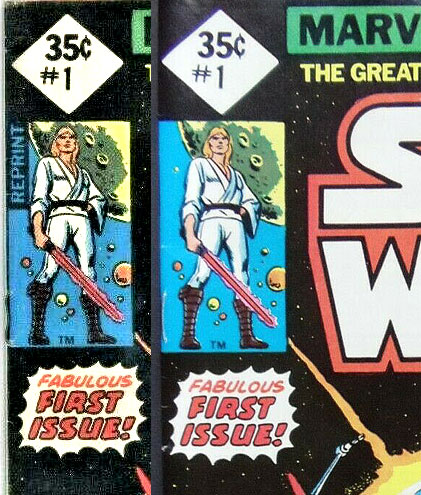
Left: one Whitman pack version says “Reprint” right on the front cover, but the other does not (you have to look in the indicia)
Collectors have sometimes been fooled into thinking the above-right Whitman version is a true 1st print copy, because it doesn’t say Reprint on the cover. But when we look in the indicia of such a copy, we indeed see that it is unmistakably a reprint. To show this, I’m going to use an example listing from eBay where the listing includes a picture of the indicia:
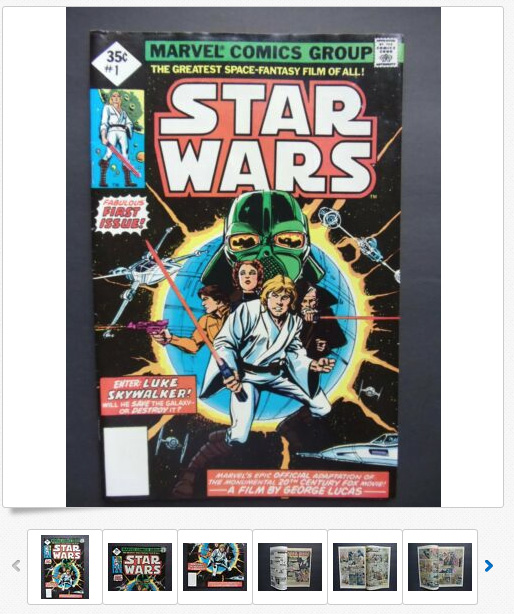
In the screenshot above, you’ll see we have a Whitman multi-pack copy of the type that does not have the word Reprint on the cover. You’ll also notice that the seller has helpfully included multiple pictures of their offered copy, including a picture of the indicia page (the 4th picture along the bottom). Let’s download that 4th picture, shall we?
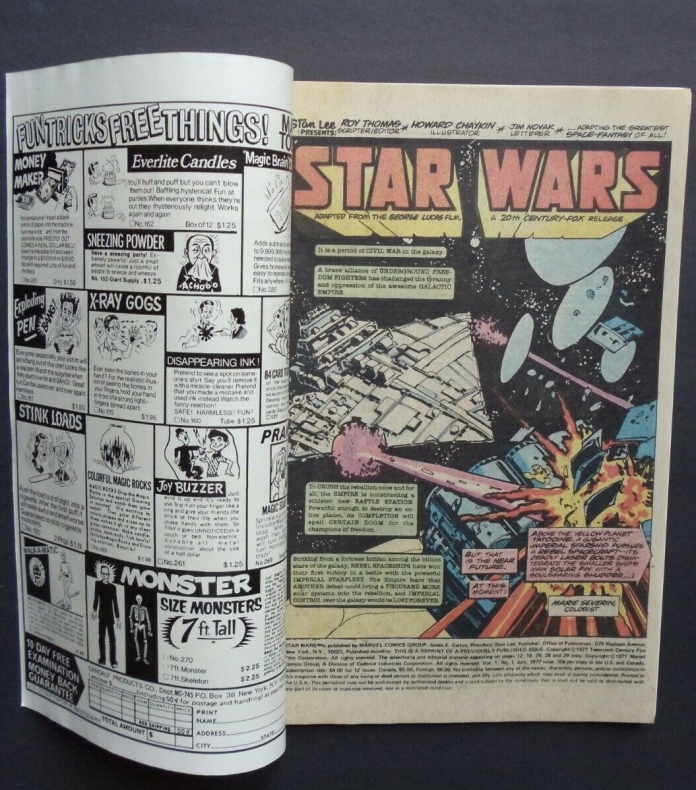
Indeed, the indicia states, in ALL CAPS, “THIS IS A REPRINT OF A PREVIOUSLY PUBLISHED ISSUE.”

Because that information is buried in the indicia, many a collector have been fooled by these 35¢ Whitman-pack copies… even CGC has been fooled into mis-labeling such a copy as a 35 cent variant, with disastrous marketplace results (some poor person bid over $1000 for the below copy mis-labeled by CGC as a 35¢ variant!):

(More details and larger pictures of this epic labeling blunder here).
And there are even reports of people doctoring books to be even sneakier, by taking a Whitman pack copy, temporarily removing the staples, and then switching out the first wrap with that of a first print copy. Sneaky stuff indeed.
With a history of collectors being swindled into buying Whitman pack copies of Star Wars #1 thinking they are buying the real 35 cent variant, it is no wonder Overstreet makes special mention in their guide that the true 35¢ cover price variant copies have the cover price in a square box and also have a UPC code box with code lines running through it (a collector might read that and make a mental note, steer clear of the blank boxes!). For Reprint copies, Overstreet describes that reprint copies will have “Reprint” in the upper left-hand corner or on the inside (as we just saw), and further describes that copies with price and number inside a diamond with no date or UPC are reprints:
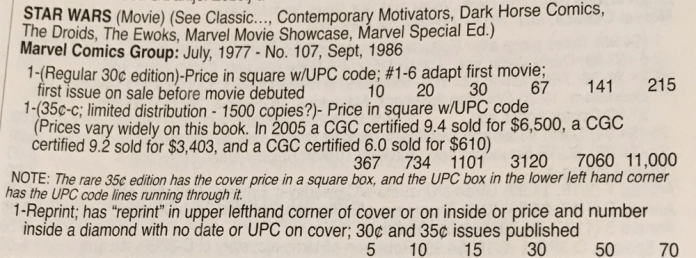
With all this hammering of “avoid! avoid! avoid!” to help people steer clear of being tricked into buying low-value reprints, it is no wonder the Whitman pack copies have developed such a stigma. Speaking for myself, this situation most certainly had an impact on me in developing a bias against all Whitman pack copies in earlier collecting days, whether that extension to all was conscious or subconscious. And I’m clearly not alone, as per Miller:
“In my column in Comics Buyer’s Guide #1609, I discussed what had been a long-held misunderstanding by many collectors — that the so-called “Whitman” Marvels were all reprints. These were the copies with the issue numbers and prices in “fat diamonds”; Nick Pope’s excellent record of them is here. Shooter said the program was developed specifically for Western Publishing and its Whitman bagged edition program, and that they were definitely printed simultaneously with the Curtis newsstand editions. The only reprints are those that are labeled as such, like Star Wars adaptation copies.”
— John Jackson Miller, Star Wars Comics Sales History
So the “avoid-this-reprint stigma” is a definite challenge for this type of variant, and it was on my mind when my own copy of the Spectacular Spider-Man #27 variant first arrived in the mail. I honestly wasn’t 100% certain what I’d see inside, as there was a sliver of doubt in me, despite knowing that these should truly be 1st print copies. And of course, when I opened the book, there, thankfully, was a regular 1st print indicia — February 1979 and no indication anywhere of being a reprint.
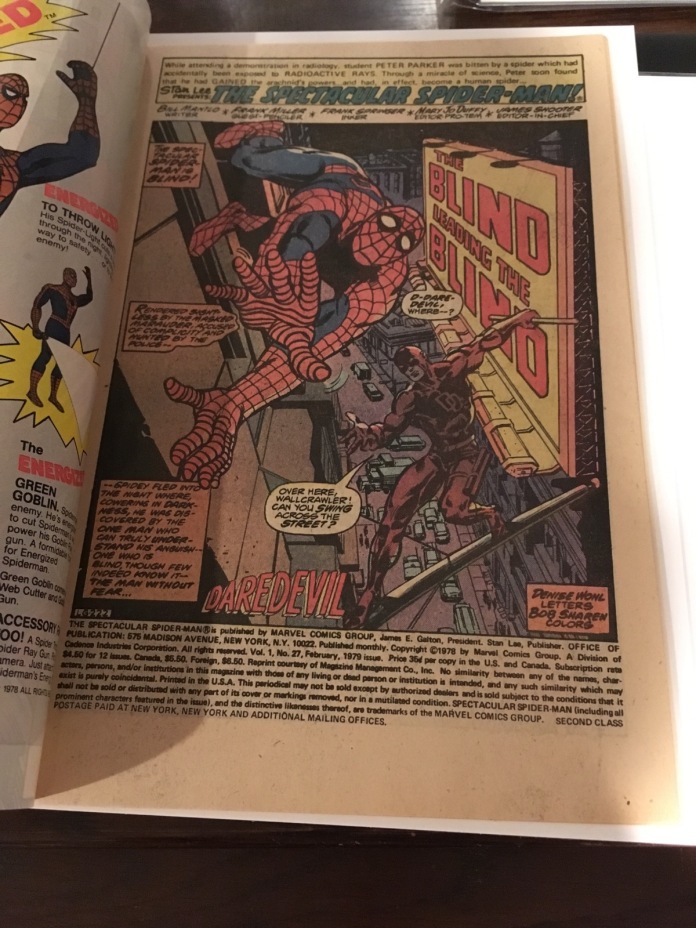
![]()
Other “No Month” Variants
In this post I’ve highlighted just three specific comics, in introductory fashion. But there are many more like these, both among DC and among Marvel issues. For Marvel issues, I have a great site to send you to — the one Miller had mentioned in a quote earlier, as having been put together by Nick Pope. Here is a link to that site: Marvel Diamond Issues, 1977-1979.
He has done a great job of documenting — with pictures included — different issues with variants as well as the various different types of cover modifications (the Spectacular #27 example I talked about today, with its missing cover month, is just one of the various types — there are others which do have a month included).
And then for DC “No Month” variants, I haven’t yet seen a comprehensive list (chime in if you know of one!) but I’ve found that eBay is a great place to look, if you search on the right term. I’ve found that searching eBay on the phrase “Pre-Pack Edition” is practically useless… right now a search on that term generates just one single search result (and it is a Marvel issue, a Whitman multi-pack copy of Shogun Warriors #1). [CGC may want to consider changing their Batman #357 naming convention away from “Pre-Pack Edition” because the marketplace just isn’t using that term.]
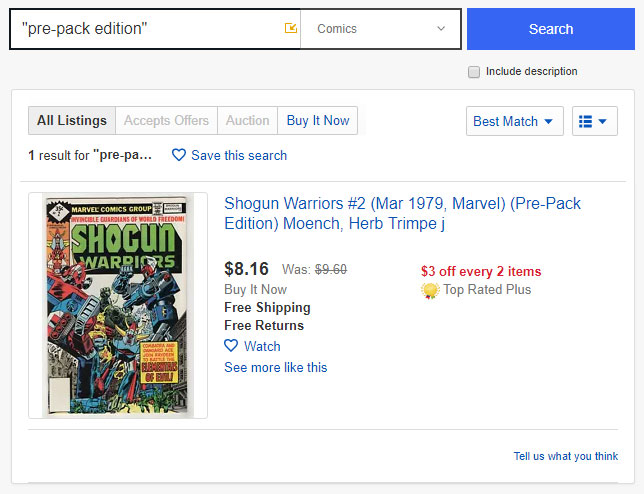
But there does seem to be enough marketplace awareness of “No Month” variants that a search of the Comics category on the phrase “No Month” produces a solid list of 78 results:

Rather than picture them here and have you scrolling down forever, here is a direct link to bring you to the search results.
But of course, many sellers are out there listing these without “No Month” (and without other variant descriptors). So if this type of variant has intrigued you and you are thinking about collecting them, another strategy for collecting them is to pick an issue to hunt for, and then scour all the listings for that issue in search of instances where the seller has pictured a variant but does not realize what they actually own and therefore titles, describes, and prices their copy for sale at “regular price”. When this strategy works (when you get the pictured book in the mail and not something else), it can get you in at a much lower cost basis than relying on a refined search.
![]()
Happy Collecting!
These are some interesting variants, wouldn’t you agree? The history is interesting to study, the comics are interesting to study, and there are quite a variety of different names people call them depending on who you ask and which issue you ask about.
Ever since the subject of “No Month” variants came up in the comments forum section of the blog, I’ve thought that maybe I should one day do a post about them that would add something interesting to what has already been published about them online by others, and ultimately I thought the idea of presenting the three main example variants I’ve covered today (Wonder Woman v2 #1, Batman #357, and Spectacular Spider-Man #27) would be an interesting approach given that each of them are separated in time by years and yet share the common attributes of (a) having been distributed in multi-packs, and (b) having no month on the cover.
These keys strike me as presenting both opportunity as well as challenges (the “reprint stigma” and for Spectacular #27 the current lack of a CGC variant census entry [but at least we have CBCS discerning them as variants]).
Placing the opportunity on one side of the scale and the challenges on the other, each collector may have their own personal scale tip in a different direction for these books; for me, the scale tipped toward wanting to collect both the Batman #357 and the Spectacular Spider-Man #27 thus far, and ever since I held them in my hands and snapped indicia photos of each, I’ve been thinking about making a post like this to share those pictures and to share the various thoughts I’ve presented today. I hope you’ve enjoyed reading it. 🙂
Happy Collecting!
– Ben p.s. I know I’ll be asked this by at least a couple of people after they read this post, so I’ll “pre-answer” the question: For the DC issues, do I prefer the “aka No Month” variant to the Canadian Price Variant newsstand copies? No way: I prefer the CPVs. But I was happy to collect my Batman #357 “aka No Month” copy too in addition to my 75¢ variant copy, because I was able to get in at a low cost basis by hunting for mis-listed opportunities.

A general comment on all of these variant types: As a collector, I prefer variants that I can see right on the comic, without referencing another comic. The same goes for variants that are visible on the front cover, because it is easier to check than the back cover. It is for those reasons that I prefer newsstand comics and the variant types mentioned here to those that look identical to their “normal” counterparts apart from having a Canadian price. For those, I have to constantly check against their same issue US counterparts to remember the pricing. This is because for every price in the Canadian pricing structure, the same price eventually finds its way onto American comics. Therefore, a sixty cent US edition has a seventy-five cent Canadian version, but a few months later, the US edition is raised to seventy-five cents, Canadian to a dollar, and then later the US edition is a dollar, and so on. I worry when buying these that I’ll be out of sync and buy the wrong one or sell one for the wrong price.
With these no date, Whitman, newsstand, etc editions, the concern of mistaking a US edition for Canadian and vice versa is gone because the “regular” editions are never marked the same way as their variant counterparts. I wonder how many other collectors feel the same way and if this affects prices? Clearly not in the case of Star Wars #1, 35 cent version, which has the same issue for me. I was just at a local comic shop and saw some early number 35 cent copies of Star Wars and was racking my brain trying to remember when the regular issues switched to 35 cents from 30. It’s a big difference for pricing, and not as easily remembered as the look of a UPC code, inclusion of a Jeweler’s insert, or the word “WHITMAN” printed on the cover.
LikeLike
Thanks Andrew, it is great to hear your perspective and I totally get what you’re saying regarding your preference for variants that you can identify quickly from the front — a feature which makes it way easier to find them in the wild when thumbing through boxes of comics. I have a couple of thoughts in reaction, the first of which is that I want to point out to you a nice “trick”/feature to know about for DC’s Canadian Price Variants:
• Every 75¢ Canadian Price Variant from DC will have the word “Canadian” on the cover just beneath the price (and regardless of specific cover price issue by issue, they will say “Canadian” below the price from 10/1982 [in the Batman title that’s at issue #352] out to 11/1983 [in the Batman title that’s at isssue #365]). So for the Batman #357 example highlighted in the above post, this is one that you actually would be able to spot in the wild just from the front cover alone when thumbing through a box of comics, without needing an outside reference point:
• And then in 12/1983 DC raised their standard Canadian price to 95¢ and changed their cover design at the same time, dropping the word Canadian. So here for example is what the price box for Batman #366 looks like for the 95¢ variant:
What this design change means is that we have one additional trick/short-cut for DC at this point forward at-a-glance from the front cover: We can use this knowledge to know at-a-glance when a 75¢ cover price DC newsstand comic is not a Canadian Price Variant… For instance, for the Wonder Woman #1 example used in the above post, if you were to come across a 75¢ newsstand copy in the wild when thumbing through a box, and it looked like this …
… then you’d be able to know immediately just at a glance that the book you found is not a 75¢ Canadian Price Variant (because if it was, it would have the price box style like the Batman #357).
• However, if you came across a $1.00 cover price newsstand copy of Wonder Woman #1 in the wild when thumbing through a box, and you didn’t already know what the cover price was supposed to be for that issue, then the point you are making about mistaking it for a regular copy certainly comes into play. And it certainly is in play for all of Marvel’s CPVs, which had no additional “Canadian” on the cover in the beginning of the window like with DC. An example I used elsewhere on the blog to make this point was to show the below single-price 75¢ Marvel comic:
Absent knowledge of what the cover price is supposed to be for the issue, one could not tell just from this picture whether the Rocket Racoon comic pictured above is a US newsstand copy or a Canadian price variant newsstand copy.
So you’re absolutely right, that if you spotted a single-price Marvel newsstand comic in the wild (or a single-price DC newsstand comic that you couldn’t rule out using the earlier trick), then you’d need to check a reference point — hopefully you’d have your phone handy and could pull up our online CPV guide which lists all the variant prices for each issue — but before our guide existed what I’d always tell people was to pull up eBay (or your favorite comic store) to quickly pull up a picture of a direct edition of the issue number, to get the reference point on cover price. But to your point, if you’re quickly thumbing through a box of comics in the wild, stopping to fiddle with your phone can slow things way down.
• Here’s my other thought in reaction. And to set it up, here is a scenario. Suppose you are out hunting in the wild for newsstand comics and thumbing quickly through a box of books. Having learned the newsstand versus direct edition difference, you can very quickly thumb through and spot when you’ve found a newsstand copy and pass over the direct editions. So let’s suppose you have found a newsstand copy. Chances are, the copy you found is going to be dual-price/multi-price, with US & Canadian (and possibly UK pence) prices. If you’re keeping an eye out for Marvel/DC Canadian price variants, you’d know this copy you found obviously isn’t one, because of the dual prices.
But what if the newsstand book you stopped at has a single price? Either the cover price amount is below 75¢ and can’t be a 1980’s Canadian Price Variant, or, it is 75¢ or higher and you haven’t memorized the expected cover price for the issue, leaving you questioning whether it might be a Canadian Price Variant you have found.
Let’s assume you’ve landed on a newsstand book in that “might be” category. You have a choice at this point: either (a) you can proceed to find out if it is a Canadian price variant (or maybe it is a DC book like Batman #357 where you can tell right away just from the front cover), or, (b) you are going to let yourself pass by the book (or buy the book) without first finding out the answer.
Perhaps at this point your choice of (a) or (b) is determined by the condition of the book you stopped at, and/or whether it falls in-between-the-keys versus being a key.
If it is a key, that brings me to my next thought/reaction:
• When going after specific keys, whether online from the comfort of your home computer/device or out in the world, chances are you already memorized a thing or two about the book you’re seeking, like why it is a key book. And one of the things you probably have looked into when studying your target book, is whether any more-rare variants exist for that book that you could choose to collect. So if you’ve already chosen a key issue to hunt for, and that key happens to have a Canadian Price Variant available as one of the collecting choices, then it would be good to arm yourself with the information in advance as to what the regular cover price is supposed to be. Granted, it can be really hard to keep track and remember the prices if one has a long list of keys they are keeping an eye out for, but, I’d think that if confronted with the situation in the wild of having just thumbed through a box of comics and spotted a key where the book might be a price variant, unsure, it should land the collector at option (a)… That because it is a key and important to them, taking a further moment to fiddle with the phone and find out if it is the Canadian price variant, is worth the while.
A final thought: for a typical seller of a 1980s comic, even if they do know about the direct edition vs. newsstand distinction, it might not occur to them when listing a stack of books one by one, that they could also possibly own a price variant. And I think that this plays right into your point about whether the aspect of the ease of mistaking a price variant for a regular copy might have an impact on market prices.
Speaking as a mis-listed-variant-hunter I think it most certainly does have an impact on me and my own behavior (and I know there are many others out there like me hunting for these mis-listed), in the following way, where the below tree shows my typical behavior historically and the “highlighted route” down the tree follows an example where I am seeking a particular book but can’t find a mis-listed variant copy:
If I feel confident enough that with patience I will be able to find a mis-listed variant for sale at “regular” price then chances are I’ll patiently wait for a mis-listed copy to come along instead of ponying up a premium for a properly listed copy. If I’m behaving this way, and if many others are behaving this way too, that has got to have an impact on market prices for the issue.
The main things that drive my behavior down the tree today for a given issue I’ve decided to hunt for are the particular issue’s scarcity and the level of marketplace awareness about its existence. I think the 35¢ variants make for a perfect example of very broad marketplace awareness: who is going to spend time scouring all the listings for a “mis-listed” 35¢ price variant copy of a given issue these days, when there are such low odds of actually finding a case where the seller owns a 35¢ variant but doesn’t realize it and therefore prices their copy for sale at the going rate for 30¢ copies? Probably not worth the time looking for such situations (but would have been worth the time back in the 90’s!).
But I still do bother looking for certain Canadian price variants mis-listed in the marketplace today — yet, having said that, sitting here in 2020 (I almost wrote 2019… which reminds me, Happy New Year!), awareness about Canadian price variants is absolutely growing out there because my experience is that it is getting harder and harder for me to find mis-listed copies. I still find them, but way less frequently. So, personally, I’m becoming more and more willing to traverse down the non-highlighted branches of the tree to the path where I’ll pay a premium for a properly listed copy.
Thanks again Andrew for sharing your perspective, I do totally get why your preference would be for variants that you can identify quickly from the front, but I hope the 75¢ DC trick helps a little in that regard the next time you spot a DC 75¢ cover price newsstand copy in the wild. [And for other single-price newsstand copies you may come across, if it is a minor or major key book in nice shape I hope you’ll find it worth the extra time to look up whether it is a CPV!]
Best,
– Ben 🙂
LikeLike
Great tips Ben. I feel Andrew’s pain in trying to remember when pricing for books changed and spotting 75 cent CPVs vs 75 US Newsstand.
Another tip is that I don’t think (correct me if I’m wrong) that US pricing for DC or Marvel books was ever 95 cents. They jumped from 75 cents to $1. So if you spot a 95 cent cover price, it’s pretty safe to know you have a CPV.
LikeLike
Would spawn 9 with no month fall into this category also?
LikeLike
A great example to bring up, Jim! Unlike the three example no-month books discussed in the above post which all share the common attribute of having been distributed in multi-packs, the Spawn #9 variants were newsstand distributed — but you’re absolutely right that among the differences the #9 variants have versus their regular counter-parts, the lack of a cover month is one of those differences.
But in terms of the “what to call them question” I think the Spawn #9 newsstand copies have a difference to regular copies that “out-ranks” the lack of month in terms of importance, and that’s the manufacturing difference: with its cheap newsprint interior pages instead of glossy. CGC deems that manufacturing difference to be a “variant-worthy attribute” and breaks them out on census (as “Newsstand Edition”) for that reason. [Whereas, as discussed with Spectacular #27 in the post above, CGC does not yet deem the “no month” attribute as variant-worthy in the case of that issue]. So although I certainly wouldn’t object to a collector calling Spawn #9 variants “no-month variants” (or including them on a “no-month list”) I think the marketplace has already settled on “newsstand” as being the common terminology for that particular variant.
There are also some cover price variants that lack a cover month. A “biggie” that comes to mind is Amazing Fantasy #15:
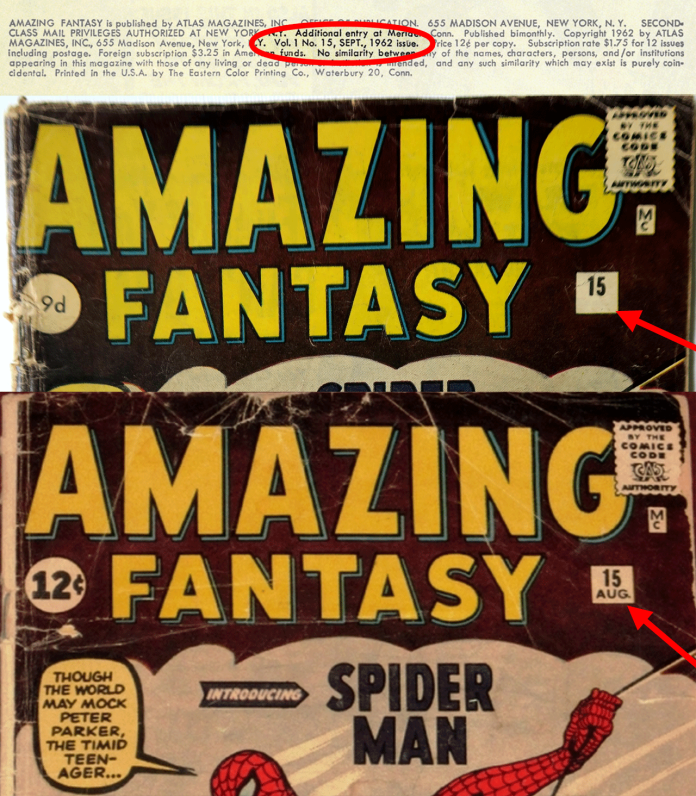
But here, among the differences, the more important difference which better “defines” the variant is the Pence cover price. Hence, here again, although I certainly wouldn’t object to a collector calling Amazing Fantasy #15 variants “no-month variants” (or including them on a “no-month list”), I think the bigger defining feature, is the 9d cover price.
Best,
– Ben
LikeLike